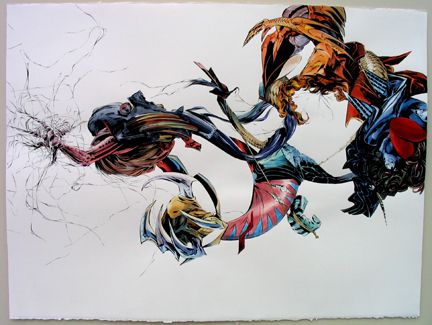Aaron Noble is a painter who uses comic books as the raw material for the work he creates. Armed with an Exacto blade, the Los Angeles-based artist combs through old comics and cuts out pieces of illustration that catch his eye. He then arranges and rearranges the comic-sourced shapes into new forms on paper. Once satisfied with a collage, he will often paint it large scale on canvas or even as giant murals in cities like San Francisco and Beijing.
Drawing heavily from the "Image revolution" style of comics, Noble's resulting pieces look less like early-'90s superheroes and their attendant carnage, and more like abstract swirls, spikes, smoke, and explosions. The biggest nerds with photographic memories will recognize elements -- Spawn's cloak here, Azrael's armored knee there. But divorced from their original framework, they take on a whole new identity -- imploding, mutated anatomies of unknown origin, alternately soaring and crawling across the canvas wrapped in computer colored hues and chrome. They are at once compelling and challenging to observe -- as the brain eagerly devours the inherent eye candy, it struggles to make sense of the improbable geometries twisting across the surface.
Of course, Noble isn't the first fine artist to use comic imagery in his work. Roy Lichtenstein, the pop art icon, is a controversial subject in comic book circles for his appropriation of comic book panels originally created by legends such as Jack Kirby, John Romita Sr., and Russ Heath. Lichtenstein's canvases were hand-painted, enlarged, recomposed, and recontextualized from the originals, but the source artists did not receive credit or a share of the millions made on the art market. Some accuse Lichtenstein's work of amounting to little more than crass plagiarism -- a charge that the Lichtenstein estate has been quick to silence with stern legal challenges.
Noble's work is clearly a different beast. The source artwork is literally deconstructed -- shapes separated from their context and reassembled into new forms that aim to elicit reactions far different from the originals. Collage has been used in fine art for thousands of years -- and unlike Lichtenstein, Noble is working in a post-digital world where the issues surrounding sampling in all media have been explored more thoroughly.
So, how much do you have to change artwork from its source to go from swipe to original? Is Noble's collage work enough? Did Lichtenstein do enough to make the plagiarism accusations unfounded? What do you think? Post your feelings in the comments section.
You can watch Nick Ferrall's this short documentary on the artist, or see more of Noble's work at his own website. Those interested in learning more about the Lichtenstein controversy should check out Deconstructing Roy Lichtenstein (at least until another cease-and-desist nasty-gram takes it down).

